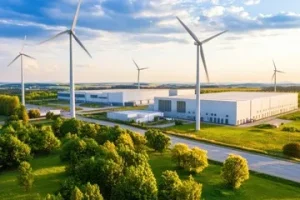The Role of Green Hydrogen Companies in India’s Energy Transition: Building a Sustainable Future
As India accelerates its journey towards a sustainable future, green hydrogen has emerged as a cornerstone of the country’s energy transition. The function of green hydrogen company in India is critical, as they spearhead the growth of green hydrogen plants and push the nation’s shift towards a cleaner, renewable energy terrain.
Let’s explore the statistics highlighting India’s significant progress and commitment towards integrating green hydrogen plants into their energy mix, underscoring the importance of this transition in achieving both environmental sustainability and economic growth.
Here they are!
- By May 2024, the Ministry of New and Renewable Energy (MNRE) awarded tenders for 412,000 tons of green hydrogen production capacity and 1,500 MW of electrolyser manufacturing capacity.
- Significant investments are being made across various states to establish Green Hydrogen Hubs or clusters of green hydrogen plants
- The government plans to support 3.6 million tons of hydrogen production over the next three years
- Approximately 3,000 MW of annual electrolyser capacity will be developed over five years.
Continuing from the previous statistics, India’s National Green Hydrogen Mission (NGHM) is pivotal in driving the country’s green hydrogen ambitions.
- Some critical aspects of the National Green Hydrogen Mission: The Indian Green Hydrogen Mission has a budget of ₹19,744 crore (approximately $2.4 billion)
- India aims to produce 5 million metric tons of green hydrogen annually by 2030
- Aims to achieve net-zero carbon emissions by 2070
- Green hydrogen is expected to reduce 3.6 gigatons of CO2 emissions in India by 2050
- Indian Green Hydrogen Mission is expected to reduce a cumulative ₹ 1 lakh crore worth of fossil fuel imports by 2030
Growing Momentum for Hydrogen: Why Now?
A Complement to Renewable Energy: Renewable Energy technologies have experienced substantial growth in both technical capabilities and cost-effectiveness. However, adequate energy storage and utilization of excess power generated during peak production hours remain critical. Hydrogen could play a key role in enhancing the efficiency and reliability of Renewable Energy systems.
Enhancing Grid Resilience with Storage Solutions: As Distributed Renewable Energy installations increase, managing grid load requirements becomes more complex. Green Hydrogen-based energy storage systems offer a viable solution for improving grid resiliency and stability.
Technological Advancements: Recent improvements in electrolyser and fuel cell technologies have enhanced their efficiency, making hydrogen a more viable energy option.
Pioneering Sustainable Energy
Green hydrogen is a clean alternative to traditional fossil fuels if obtained from renewable sources like solar and wind. Green hydrogen companies in India are at the forefront when speaking about green hydrogen plants, which expedite harnessing their abundant renewable resources. Such companies help decarbonize the steel, cement, and mobility industries and will make India a leader in green hydrogen production globally.
The Role of Green Hydrogen in Industrial Decarbonization
Green hydrogen holds immense potential in decarbonizing industries that are traditionally hard to electrify. The steel, cement, and mobility sectors are major contributors to carbon emissions, but with the help of green hydrogen companies in India, these industries are gradually transitioning to cleaner energy alternatives. Green hydrogen can replace coal and natural gas in steel production, power cement kilns, and serve as a clean fuel for heavy-duty vehicles. As India continues to scale up its green hydrogen infrastructure, these industries will be key drivers in reducing the nation’s carbon footprint.
India’s Future as a Green Hydrogen Hub
India’s commitment to green hydrogen is set to reshape its energy landscape. With vast renewable energy resources and supportive government policies, the country is positioning itself as a global hub for green hydrogen production. By 2030, India aims to meet its hydrogen demand through renewable energy sources, boosting domestic manufacturing and creating jobs in the process. As green hydrogen plants become more widespread, India’s leadership in clean energy technology will not only contribute to its economic growth but also foster global collaboration in achieving net-zero emissions.
Meeting National Goals
Ambitious targets set by the Indian government in its Green Hydrogen Mission stipulate 5 million metric tons of green hydrogen annually by 2030. Companies developing green hydrogen take front-row seating to meet this goal and lead innovation and investment in new technologies and infrastructure. A funding of ₹19,744 crore ($2.4 billion) for this mission ensures that these companies help India reduce dependence on fossil fuels while meeting the renewable energy targets.
Shaping a Sustainable Future
The role of green hydrogen companies in India’s energy transition goes beyond reducing emissions to building a sustainable future. The Green Hydrogen Company in India would not only establish green hydrogen plants but would also help propel a shift of the nation towards sustainable energy. Propelling green hydrogen adoption, these companies will aid India in achieving set climate goals while being some of the most important drivers of growth and innovation within the renewable energy sector. Green hydrogen plants do not simply deal with energy production; they symbolize a commitment to India’s sustainable future. These plants will play a key role in enabling large-scale adoption of green hydrogen in meeting India’s climate goals and reducing emissions for the green energy movement worldwide.
Driving Decarbonization
Green hydrogen companies in India are helping to decarbonize hard-to-electrify sectors like steel, cement and transportation. According to government estimates, green hydrogen alone has the potential to reduce around 3.6 gigatons of CO2 by 2050 in India. Indian corporates, with huge balance sheets behind them, are already investing considerable sums into green hydrogen. Reliance Industries, for instance, has said it will plow $10 billion into clean energy including green hydrogen over the next three years.
Challenges and Opportunities
While the potential of green hydrogen is vast, challenges remain, including high production costs and the need for advanced infrastructure. However, with global costs expected to decrease by 30% by 2030 and ongoing government support, green hydrogen companies are well-positioned to overcome these obstacles and make green hydrogen a mainstream energy source.
Moreover, India is working on creating a favorable regulatory environment to encourage investment in green hydrogen. The National Hydrogen Energy Mission includes plans to build hydrogen hubs, develop storage and distribution infrastructure, and foster public-private partnerships to drive innovation and scale.
For any green hydrogen company in India, these developments present both a challenge and an opportunity. Navigating regulatory frameworks, accessing subsidies, and building integrated ecosystems are crucial to long-term success. However, companies that invest early in technology, infrastructure, and partnerships stand to become leaders in this transformative sector.
As the demand for clean energy rises, being a green hydrogen company in India comes with strategic advantages—abundant renewable energy resources, a growing skilled workforce, and strong governmental support. These factors can help reduce reliance on imported fuels while positioning India as a global hub for hydrogen exports.
Ultimately, for every green hydrogen company in India, the path forward involves balancing innovation, affordability, and scalability to play a defining role in the global energy transition.
Nurturing a Sustainable Future
The role of green hydrogen companies in India’s energy transition is not just about reducing emissions but building a sustainable future for generations. By embracing green hydrogen, companies are moving towards a cleaner energy system and paving the way for global leadership in renewable energy. As these companies continue to innovate and expand, green hydrogen will play an increasingly vital role in India’s energy mix, driving the country closer to its vision of a sustainable and prosperous future. Green hydrogen plants are a cornerstone of India’s sustainable energy strategy, offering a pathway to a cleaner, greener future while driving economic growth and technological innovation.
India is rapidly advancing in the green hydrogen sector, driven by a commitment to sustainability and energy independence. Green hydrogen, produced using renewable energy sources like solar and wind, represents a transformative solution for reducing greenhouse gas emissions across industries. Companies like Adani Green Energy, Reliance Industries, and NTPC are spearheading ambitious projects through strategic partnerships to establish India as a global leader in green hydrogen, highlighting the nation’s focus on integrating clean technologies with industrial processes.
The role of green hydrogen in decarbonizing hard-to-abate sectors, such as steel, transportation, and chemicals, is gaining momentum. With the National Green Hydrogen Mission and significant investments from industry leaders, India is setting benchmarks for hydrogen adoption. Pioneering companies are deploying advanced electrolysers and leveraging renewable resources to produce sustainable hydrogen, including the use of green ammonia as a storage solution. These efforts align with both domestic needs and international energy goals, positioning India at the forefront of the global green hydrogen and ammonia markets.
Yonder H2, part of the Ador Group, exemplifies innovation in India’s green hydrogen ecosystem. Specializing in DC power supplies for hydrogen electrolysers, Yonder integrates cutting-edge technologies to support MW-scale hydrogen production and the production of green hydrogen. By leveraging over four decades of expertise in power electronics, the company is empowering green hydrogen projects with tailored, cost-effective solutions. Yonder H2 also addresses critical factors to split water into hydrogen and oxygen efficiently, ensuring high output and operational reliability.
As a company that plays a leader in green hydrogen, Yonder H2 supports the Ministry of Green Hydrogen stocks in India and advances storage solutions and scalable production methods for producing green hydrogen. Their efforts align with India’s focus on reducing dependency on crude oil and natural gas, contributing to a more sustainable energy landscape. Yonder H2’s commitment to Environmental, Social, and Governance (ESG) principles underscores its role in driving innovation and supporting India’s clean energy transition.
India’s Role in a Sustainable Energy Future
India is rapidly emerging as a global hub for the production of green hydrogen, driven by its abundant renewable energy sources such as solar and wind power. The country’s National Green Hydrogen Mission supports this transition by enabling green hydrogen companies to scale operations, build infrastructure, and invest in innovation. By aiming to split water into hydrogen and oxygen using clean electricity, India is not only reducing carbon emissions, but also building a robust green hydrogen industry.
As the country seeks to reduce dependence on fossil fuels and cut fossil fuel imports, the green hydrogen sector is becoming central to its energy strategy. Government-backed green hydrogen projects are focused on producing green hydrogen for use in industries, transport, and power generation, while also positioning India as a future exporter of green hydrogen. This transformation supports broader goals of reducing carbon output and transporting and distributing clean fuel for a sustainable future, both domestically and internationally.
Ready to power a sustainable future? Contact us at yonderh2@adorpower.com to learn more about green hydrogen solutions.
Yonder, a division of the Ador Group, has been a leader in Power Electronics since 1908. Specializing in advanced Power Conversion Units for hydrogen generation, we integrate Alkaline, PEM electrolyser, SOEC, and AEM electrolysers to ensure high efficiency and minimal power consumption. Headquartered in Mumbai with state-of-the-art facilities in Pune, Yonder is committed to global decarbonization. Our 500-MW manufacturing facility for hydrogen power sources is poised to deliver cutting-edge solutions that thrive in unique and demanding deployment contexts.





